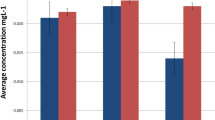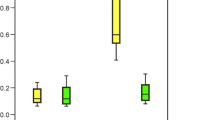Abstract
Nickel constitutes about 8–60 % of orthodontic alloys. It is known as an allergenic/cytotoxic trace metal. Therefore, it should be investigated in patients undergoing orthodontic treatment which might last for 2 or 3 years. However, no controlled studies have assessed the influence of orthodontic treatments of longer than 5 months on its systemic levels. Thus, the aim of this retrospective cohort study was to evaluate systemic nickel in patients undergoing orthodontic therapy for a minimum period of 1 year. In this study, urinary nickel concentrations in 20 female and 10 male patients being treated with stainless steel appliances were measured using atomic absorption spectrophotometry. The same procedure was done on a control group of the patients’ same-gender near-age siblings (n = 30). The effect of treatment and gender on urinary nickel levels were assessed using a repeated-measures two-way analysis of variance (ANOVA) and a Tukey test (α = 0.05). The mean treatment duration was 17.1 ± 6.4 months (range, 12–21). The mean nickel concentrations in male and female patients were 9.67 ± 3.25 and 9.9 ± 3.83 μg/L, respectively. These statistics for male and female control subjects were 6.65 ± 2.57 and 8.43 ± 2.94 μg/L, respectively. The ANOVA showed a statistically significant difference between the urinary nickel levels of the treatment and the control groups (P = 0.009) but not between the genders (P = 0.194). The interaction between gender and treatment was also nonsignificant (P = 0.337). The Tukey test indicated that the increase in nickel was higher in male patients, in comparison to their brothers (P < 0.05). It could be concluded that orthodontic therapy for longer durations with stainless-steel archwires might elevate slightly, but significantly, urinary nickel levels.

Similar content being viewed by others
References
Eliades T, Pratsinis H, Kletsas D, Eliades G, Makou M (2004) Characterization and cytotoxicity of ions released from stainless steel and nickel–titanium orthodontic alloys. Am J Orthod Dentofac Orthop 125:24–29
House K, Sernetz F, Dymock D, Sandy JR, Ireland AJ (2008) Corrosion of orthodontic appliances—should we care? Am J Orthod Dentofac Orthop 133:584–592
Amini F, Borzabadi Farahani A, Jafari A, Rabbani M (2008) In vivo study of metal content of oral mucosa cells in patients with and without fixed orthodontic appliances. Orthod Craniofac Res 11:51–56
Matos de Souza R, Macedo de Menezes L (2008) Nickel, chromium and iron levels in the saliva of patients with simulated fixed orthodontic appliances. Angle Orthod 78:345–350
Amini F, Jafari A, Amini P, Sepasi S (2012) Metal ion release from fixed orthodontic appliances—an in vivo study. Eur J Orthod 34:126–130
Eliades T, Athanasiou AE (2002) In vivo aging of orthodontic alloys: implications for corrosion potential, nickel release, and biocompatibility. Angle Orthod 72:222–237
Amini F, Rakhshan V, Mesgarzadeh N (2012) Effects of long-term fixed orthodontic treatment on salivary nickel and chromium levels: a 1-year prospective cohort study. Biol Trace Elem Res. doi:101007/s12011-012-9457-y
Hwang CJ, Shin JS, Cha JY (2001) Metal release from simulated fixed orthodontic appliances. Am J Orthod Dentofac Orthop 120:383–391
Eliades T, Trapalis C, Eliades G, Katsavrias E (2003) Salivary metal levels of orthodontic patients: a novel methodological and analytical approach. Eur J Orthod 25:103–106
Mikulewicz M, Chojnacka K (2010) Trace metal release from orthodontic appliances by in vivo studies: a systematic literature review. Biol Trace Elem Res 137:127–138
Mikulewicz M, Chojnacka K (2011) Release of metal ions from orthodontic appliances by in vitro studies: a systematic literature review. Biol Trace Elem Res 139:241–256
Agaoglu G, Arun T, Izgi B, Yarat A (2001) Nickel and chromium levels in the saliva and serum of patients with fixed orthodontic appliances. Angle Orthod 71:375–379
Amini F, Rakhshan V, Pousti M, Rahimi H, Shariati M, Aghamohamadi B (2012) Variations in surface roughness of seven orthodontic archwires: an SEM-profilometry study. Korean J Orthod 42:129–137
Fors R, Persson M (2006) Nickel in dental plaque and saliva in patients with and without orthodontic appliances. Eur J Orthod 28:292–297
Mikulewicz M, Chojnacka K (2011) Cytocompatibility of medical biomaterials containing nickel by osteoblasts: a systematic literature review. Biol Trace Elem Res 142:865–889
Kuhta M, Pavlin D, Slaj M, Varga S, Lapter-Varga M (2009) Type of archwire and level of acidity: effects on the release of metal ions from orthodontic appliances. Angle Orthod 79:102–110
Macedo de Menezes L, Cardoso Abdo Quintão C (2010) The release of ions from metallic orthodontic appliances. Semin Orthod 16:282–292
Freitas MP, Oshima HM, Menezes LM (2011) Release of toxic ions from silver solder used in orthodontics: an in-situ evaluation. Am J Orthod Dentofac Orthop 140:177–181
Pazzini CA, Junior GO, Marques LS, Pereira CV, Pereira LJ (2009) Prevalence of nickel allergy and longitudinal evaluation of periodontal abnormalities in orthodontic allergic patients. Angle Orthod 79:922–927
Kusy RP (2004) Clinical response to allergies in patients. Am J Orthod Dentofac Orthop 125:544–547
Li Z, Gu JY, Wang XW, Fan QH, Geng YX, Jiao ZX, Hou YP, Wu WS (2010) Effects of cadmium on absorption, excretion, and distribution of nickel in rats. Biol Trace Elem Res 135:211–219
Petoumenou E, Arndt M, Keilig L, Reimann S, Hoederath H, Eliades T, Jager A, Bourauel C (2009) Nickel concentration in the saliva of patients with nickel–titanium orthodontic appliances. Am J Orthod Dentofac Orthop 135:59–65
Menezes LM, Quintao CA, Bolognese AM (2007) Urinary excretion levels of nickel in orthodontic patients. Am J Orthod Dentofac Orthop 131:635–638
Bishara SE, Barrett RD, Selim MI (1993) Biodegradation of orthodontic appliances. Part II. Changes in the blood level of nickel. Am J Orthod Dentofac Orthop 103:115–119
Fairbrother A, Wenstel R, Sappington K, Wood W (2007) Framework for metals risk assessment. Ecotoxicol Environ Saf 68:145–227
Jerrold B, Leikin FPP (2007) Poisoning and toxicology handbook. LexiComp, Chicago
Santucci B, Manna F, Cannistraci C, Cristaudo A, Capparella R, Bolasco A, Picardo M (1994) Serum and urine concentrations in nickel-sensitive patients after prolonged oral administration. Contact Dermatitis 30:97–101
Author information
Authors and Affiliations
Corresponding author
Rights and permissions
About this article
Cite this article
Amini, F., Rakhshan, V. & Sadeghi, P. Effect of Fixed Orthodontic Therapy on Urinary Nickel Levels: A Long-term Retrospective Cohort Study. Biol Trace Elem Res 150, 31–36 (2012). https://doi.org/10.1007/s12011-012-9478-6
Received:
Accepted:
Published:
Issue Date:
DOI: https://doi.org/10.1007/s12011-012-9478-6




